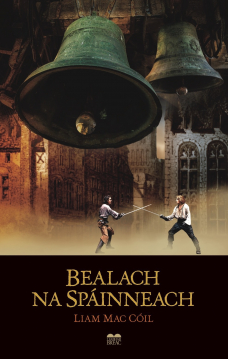Bealach na Spáinneach. Liam Mac Cóil. Leabhar Breac; 604pp; €15 pb; 9781909907713.
Bealach na Spáinneach is the third and final part of Liam Mac Cóil’s trilogy of historical novels set in 1612 when there remained a possibility that departed Gaelic leader Hugh O’Neill, Earl of Tyrone, might return to Ireland with an army to expel the English.
In the first book, An Litir (2011), a young Galway student, Lúcás Ó Briain, is entrusted to deliver a letter into the hands of the Great O’Neill in Rome. From the outset the messenger is being followed and desperate efforts are made to take the letter from him. Thanks to his skill as a swordsman and some good fortune, he manages a dramatic escape from Galway. In the follow up, I dTír Strainséartha (2014), the close pursuit continues across England and, having narrowly escaped capture and death, the young hero again manages to keep the letter safe and make his way to the English Channel and safety, if he can survive a winter storm and shipwreck.
Both books of swashbuckling derring-do were highly praised by critics and readers alike and garnered a number of literary prizes for Mac Cóil and Leabhar Breac. Fans of the series, like myself, had been waiting impatiently for the final part of the trilogy. Given that the first part took almost 300 pages to get Lúcás out of Galway and the second nearly 400 pages to get him across England, many of us wondered if his perilous journey to Rome might need a fourth or fifth volume, but this third volume has completed the trilogy. Bealach na Spáinneach stretches to just over 600 pages, bringing the whole saga to almost 1,300 pages, an exceptional achievement in contemporary Irish-language fiction. The author and publisher are to be congratulated for the sustained effort and dedication to their task.
The final stages of his journey take Lúcas from the French coast to Rome, largely following the route taken by the leaders of Gaelic Ulster. Mac Cóil gives us excellent and credible pen-pictures of the countryside and cities as Ó Briain’s odyssey takes him through Ostend, Bruges, Brussels, Basel, Lucerne, Milan and Rome. There is loads of wonderful, descriptive and atmospheric writing here, and I often felt as if I were being transported through the genre paintings and landscapes of seventeenth-century Europe as the chase wound its way through narrow streets, into tempting inns and over mountain passes. There is betrayal and bloodshed, intrigue and distrust, physical and moral challenge as the young student encounters a series of friends and foes.
On his adventures Lúcás encounters some of the major personalities and Irish-language writers of the early seventeenth century, such as Aodh Mac Aingil, Flaithrí Ó Maoil Chonaire, Bonaventura Ó hEosa, Peter Lombard and Luke Wadding. The complex literary, historical, philosophical and religious conflicts of the time are artfully included in the criss-crossing strands of Mac Cóil’s tapestry. There are twists and turns in the plot that bring the adventure to an unexpected conclusion. Of course, O’Neill never made it back with an army to reconquer Ireland but that is not to say that Lúcás Ó Briain did not complete his mission.
Bealach na Spáinneach is a rollicking yarn with a well-researched credible physical and historical backdrop, including walk-on characters and places from the pages of history. I wasn’t just as enthralled by this final volume as I was by the first two, and it is quite possible that facing into 600 pages may have predisposed me to impatience. Sometimes I became slightly irritated by the protagonist’s constant naivety. For example, until prompted to by another character, over 400 pages in, the idea of disguising himself from his enemies doesn’t seem to occur to him, and he regularly introduces himself as Luke, an Irish student on his way to Rome, even detailing his itinerary as if an extra gift to his pursuers. Talk about asking for trouble and getting it!
Throughout, Mac Cóil writes with beguiling ease and his knowledge of the period is presented in ways that are subtle and relevant to the story. While much of the period detail was wonderful, and the hero’s language-learning initially interesting, I couldn’t help feeling that a few more telling slashes of the editor’s rapier might have given us an even more laudable performance. Don’t get me wrong, Bealach na Spáinneach is the crowning achievement of a wonderfully exciting trilogy and I would advise anyone with a love of adventure stories or historical fiction to follow Lúcás Ó Briain across early seventeenth-century Europe from Galway to Rome.
Cathal Póirtéir

Cathal Póirtéir is a writer and broadcaster who has published several books and CDs on Irish folklore, social history and literature in Irish.













